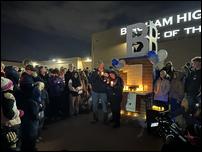Estimated read time: 3-4 minutes
- The Nov. 6 explosion of a South Jordan house, which killed a 15-year-old, was linked to a gas pipeline installed in 1976.
- Enbridge Gas Utah identified the leak on a 4-inch Aldyl A gas main, known for potential vulnerabilities.
- The gas company and South Jordan city administrators urge residents to install gas alarms in their homes.
SOUTH JORDAN — The source of a gas leak that caused a South Jordan house to explode, resulting in the death of a 15-year-old boy, was a gas line located about 150 feet northeast of the home, installed in the 1970s, according to a new report.
The National Transportation Safety Board on Wednesday released a preliminary report on the Nov. 6 explosion and fire. On that day, an explosion was reported at a house at 10593 S. 3210 West in South Jordan. Logan Hansen, a student at Bingham High School, was found dead inside the home about seven hours later.
Enbridge Gas Utah, which acquired Dominion Energy in June, located the gas leak believed to have caused the explosion on Nov. 7, according to the report.

"Enbridge found a leak about 150 feet northeast of the home on a 4-inch diameter Aldyl A natural gas main it owned and operated. The Aldyl A main was manufactured and installed in 1976," the report states. The leak was located under the median of 3200 West, behind the rear of the home.
The safety board noted an Aldyl A pipe "is the trademarked name of a polyethylene plastic gas pipeline product that was manufactured by the DuPont Chemical Company using a proprietary polymer resin. It is no longer manufactured or used in new pipelines."
According to findings by the company Exponent, which bills itself as a "premium global engineering and scientific consulting firm" since 1967, "Aldyl A polyethylene pipe is now being identified and removed in several states due to its potential vulnerabilities." Those vulnerabilities include "rapid crack propagation, ductile rupture and slow crack growth."
The National Transportation Safety Board report states pressure in that pipe was operating below the legal maximum level at the time of the explosion.
Related:
"Enbridge detected subsurface gas between the main and two neighboring residences, including the accident home and the home immediately to the north. The subsurface gas extended from the main to the backyard and front yard of each home, reaching about 250 feet from the leak," according to the report.
The investigation by the agency — which is known for investigating crashes involving aircraft, but also watches over the transportation of natural gas — is ongoing and will now look at Enbridge's integrity management program and pipeline safety management system.
In a prepared statement on Wednesday, Enbridge said, "Our company has been a part of the Utah community for over 95 years and public safety is always our top priority. We are deeply saddened by this event and our hearts and prayers go out to the Hansen family for their tragic loss. NTSB has published its preliminary report and while federal regulations prohibit us from commenting on the ongoing investigation, we remain committed to continuing to contribute to the investigation."
The agency also recommends all residences have natural gas alarms or methane detectors.
Late Wednesday afternoon, South Jordan city administrators reacted to the report in a prepared statement.
"We know this news may raise questions and concerns about the safety of the transmission lines in our community and how it may relate to your own home and we want residents to feel safe. Our public safety team is working closely with residents in the immediately affected neighborhood to share information and provide some additional testing," the city stated while also encouraging residents to get natural gas detectors in their homes.










